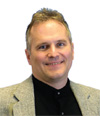New Chips Might Lead the Next PC Revolution
Latest News
May 30, 2009
By Peter Varhol
 |
Part of the PC’s longevity as a tool for serious work is due to its versatility. On the surface, it is a completely different machine than the one spec’d out by IBM back in 1981, yet the hardware and operating software work in fundamentally the same ways. Running Windows, it is still possible to drop down into a command line that looks and behaves like the original DOS, which can still run many of the applications from 25 years ago.
Under the covers, however, virtually everything is different. A processor that began with eight bits of addressable space and running at 4.77MHz now has up to 64 bits of address space, up to 3GHz of speed, and multiple processor cores. The memory buses themselves can run up to 600MHz.
The continual rebirth of the PC as a working computer means that its architecture and design has to keep up with the times. Now we may be seeing the beginning of the next rebirth.
Performance once again is poised to make a big leap. It starts with Intel’s Nehalem architecture, which is revolutionary in a number of ways that will benefit users such as engineers who require very high-performance systems.
One significant innovation in Nehalem is its so-called Turbo Boost Technology, which delivers additional performance automatically when needed by taking advantage of the processor’s power and thermal headroom. It does so using a technique that we once called overclocking. It was well known—to those of us who built our own PCs 15 or 20 years ago—that the Intel processors were capable of running faster than their rated clock speeds. Replacing the clock crystal with a faster one was an easy way of getting a computer to run faster with a slower and less-expensive processor.
Nehalem does it in a different way. It detects when a processor core is running at close to capacity, then overclocks itself one step at a time to be able to run its workload more easily. As the workload diminishes, it clocks back down to its normal speed.
The processor also incorporates scalable shared memory with memory distributed to each processor with integrated memory controllers and high-speed point-to-point interconnects. Specifically, it has the memory controller on chip, rather than across the memory bus on a separate chip. This enables the controller to understand what is happening in the processing pipeline and make fetch decisions based on that tight coupling.
This approach has the potential to improve performance by ensuring that data and instructions are ready to go so that pipeline stalls become less common.
And engineers can now buy PCs with the Nehalem architecture and even more memory than they may have thought possible. At the end of March, Dell announced the Precision T3500, T5500, and T7500, a computer line that incorporates the Nehalem architecture and high-end NVIDIA and ATI graphics processors. Perhaps most impressive, the top-of-the-line T7500 has a maximum memory capacity of an incredible 192GB.
I saw a pre-launch T7500 that was able to render complex designs in a minute or two—designs that took 10 minutes or more on earlier high-performance systems. The interior of the tower system is elegantly designed, fitting dual processors, 12 memory slots, and assorted other hardware in a standard case.
There is no question that the Nehalem-based systems have the potential to dramatically change design engineering. While the entry price is still fairly high, these systems provide engineers with the power to do design and simulation tasks that weren’t possible on the desktop in the past, or that took significantly longer to accomplish. The result may be the next revolution in PC computing.
Peter Varhol has been involved with software development and systems management for many years. Send comments about this column to [email protected].
Subscribe to our FREE magazine, FREE email newsletters or both!
Latest News
About the Author
Peter VarholContributing Editor Peter Varhol covers the HPC and IT beat for Digital Engineering. His expertise is software development, math systems, and systems management. You can reach him at [email protected].
Follow DE





